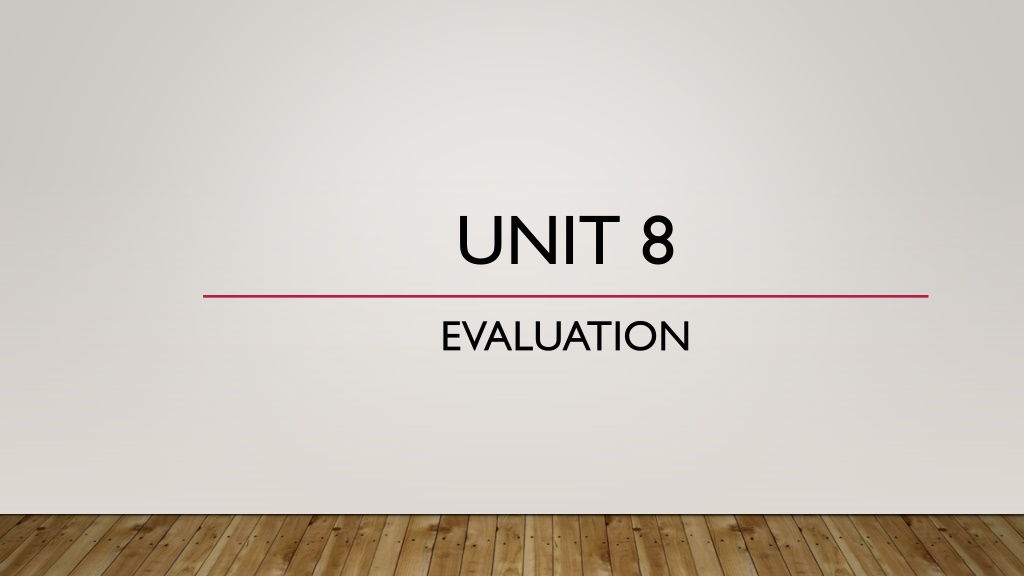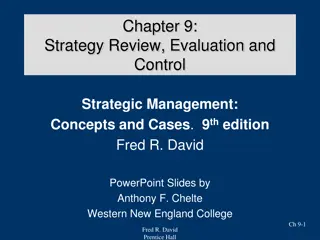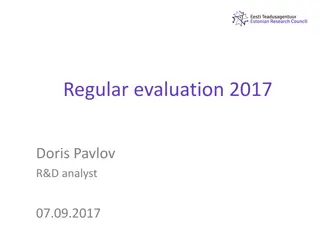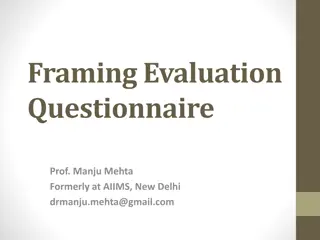Understanding Evaluation in Education
Evaluation in education is a comprehensive term that encompasses measurement, testing, and qualitative examination of student behavior. It involves both quantitative and qualitative descriptions, along with value judgments. Differentiating from mere measurement, evaluation provides a deeper analysis of student performance and aims to determine the extent to which instructional objectives are being achieved. The main objective of evaluation is to offer continuous feedback to teachers and students, highlighting learning successes and identifying areas needing improvement. There are four main types of evaluation: placement evaluation, formative evaluation, diagnostic evaluation, and summative evaluation.
Download Presentation

Please find below an Image/Link to download the presentation.
The content on the website is provided AS IS for your information and personal use only. It may not be sold, licensed, or shared on other websites without obtaining consent from the author. Download presentation by click this link. If you encounter any issues during the download, it is possible that the publisher has removed the file from their server.
E N D
Presentation Transcript
UNIT 8 EVALUATION
INTRODUCTION The terms measurement and evaluation assessment are sometimes used interchangeably; The word evaluation is often confused with assessment, testing and measurement. Testing is only a technique to collect evidence regarding pupil behaviour. Measurement on the other hand, is limited to quantitative description of the student behaviour.
CONT Evaluation is a more comprehensive term which includes testing and measurement and also qualitative description of the student behaviour. It also includes value judgment regarding the worth or desirability of the behaviour measured or assessed.
CONT Considering the importance of this relationship, Gronlund has indicated this relationship in the following equation: Measurement = quantitative description of pupils (measurement) + value judgment Evaluation = qualitative description of pupils (non-measurement) + value judgment Thus, evaluation may not be based on measurement alone but it goes beyond the simple quantitative score.
MEANING OF EVALUATION Evaluation is a broader term than the Measurement. It is more comprehensive than Measurement. It goes ahead of measurement which simply indicates the numerical value. It gives the value judgement to the numerical value. It includes both quantitative and qualitative descriptions. (i) Quantitative description (ii) Qualitative description (iii) Value judgment
CONT According to Gronlund and Linn: "Evaluation is the systematic process of collecting, analyzing and interpreting information to determine the extent to which pupils are achieving instructional objectives." (Answers the question "How Good")
OBJECTIVE OF EVALUATION Its main objective is to provide continuous feedback to both teacher and student concerning learning successes and failures while instruction is in process. Feedback to students provides reinforcement of successful learning and identifies the specific learning errors that need correction.
TYPES OF EVALUATION There are four main types of evaluation. 1. Determine pupil performance at the beginning of instruction (placement evaluation). 2. Monitor learning progress during instruction (formative evaluation). 3. Diagnose learning difficulties during instruction (diagnostic evaluation). 4. Evaluate achievement at the end of instruction (summative evaluation).
PLACEMENT EVALUATION Placement evaluation is designed to place the right person in the right place. It ensures the entry performance of the pupil. The future success of the instructional process depends on the success of placement evaluation. Placement evaluation is concerned with the student's entry performance and typically focuses on questions such as:
CONT a. Does the pupil possess required knowledge and skills for the instruction? b. Whether the pupil has already mastered some of the instructional objectives or not? c. Whether the mode of instruction is suitable to pupil s interests, work habits and personal characteristics? This type of evaluation is helpful for admission of pupils into a new course of instruction.
EXAMPLES: i. Aptitude test ii. Self-reporting inventories iii. Observational techniques iv. Medical entrance exam. v. Engineering or Agriculture entrance exam. Vi. Other type of entry tests
FORMATIVE EVALUATION Formative evaluation is used to monitor the learning progress of students during the period of instruction. Its main objective is to provide continuous feedback to both teacher and student concerning learning successes and failures while instruction is in process.
CONT Feedback to students provides reinforcement of successful learning and identifies the specific learning errors that need correction. Feedback to teacher provides information for modifying instruction and for prescribing group and individual remedial work.
FEATURES OF FORMATIVE EVALUATION 1. It is assessment made during instruction. 2. It monitors learning progress during instruction. 3. It continuously provides feedback for pupils. 4. Feedback to pupils reinforces successful learning. 5. It also identifies learning errors that need correction. 6. Formative Assessment provides feedback to teacher concerning learning successes and failures. 7. Feedback to teachers provides information for modifying instruction / method.
EXAMPLES i. Monthly tests. ii. Class tests. iii. Periodical assessment. iv. Teacher s observation, etc.
DIAGNOSTIC EVALUATION It is concerned with identifying the learning difficulties or weakness of pupils during instruction. It tries to locate or discover the specific area of weakness of a pupil in each course of instruction and also tries to provide remedial measure. N.E. Gronlund says formative evaluation provides first-aid treatment for simple learning problems whereas diagnostic evaluation searches for the underlying causes of those problems that do not respond to first-aid treatment.
CONT When the teacher finds that in spite of the use of various alternative methods, techniques and corrective prescriptions the child still faces learning difficulties, he takes recourse to a detailed diagnosis through specifically designed tests called diagnostic tests . Diagnosis can be made by employing observational techniques, too. In case of necessity the services of psychological and medical specialists can be utilized for diagnosing serious learning handicaps.
FEATURES 1. It determines the causes of learning problems. 2. It formulates a plan for remedial action. 3. It is comprehensive and detailed search. 4. It needs the help of psychological, medical and subject experts. 5. It helps in vocational, individual and social guidance. Tools of Diagnostic Evaluation: 1. Diagnostic Tests 2. Observation Techniques
SUMMATIVE EVALUATION Summative evaluation is done at the end of a course of instruction to know to what extent the objectives previously fixed have been accomplished. In other words, it is the evaluation of pupils achievement at the end of a course. The main objective of the summative evaluation is to assign grades to the pupils. It indicates the degree to which the students have mastered the course content. It helps to judge the appropriateness of instructional objectives. Summative evaluation is generally the work of standardized tests
FEATURES 1. It is assessment made at the end of the program. 2. It determines the overall success or failure of pupil. 3. It is more comprehensive and vaster. 4. It is used for promotion, certification and grading, 5. It identifies the academic potential. 6 It helps in future decisions and predictions. 7. It also helps in comparing the performances of different groups.
EXAMPLES 1. Traditional school and university examination, 2. Teacher-made tests, 3. Standardized tests, 4. Practical and oral tests, and 5. Rating scales, etc.
CHARACTERISTICS OF GOOD TESTS Validity Reliability Objectivity Usability Administrability
VALIDITY The first important characteristic of a good test is validity. It means that it measures what it is supposed to measure. It tests what it ought to test. Validity explains us whether the test fulfils the objective of its development. There are many methods to assess validity of a test.
RELIABILITY A good test should be highly reliable. This refers to the extent to which they obtained results are consistent or reliable. When the test is administered on the same sample for more than once with a reasonable gap of time, are liable test will yield same scores. It means the test is trustworthy. Reliability is defined as the extent to which an assessment yields consistent information about the knowledge, skills, or abilities being assessed. An assessment is considered reliable if the same results are yielded each time the test is administered
OBJECTIVITY By objectivity of a measuring instrument is meant for the degree to which equally competent users get the same results. This presupposes subjective factor. A test is objective when it makes for the elimination of the scorer s personal opinion bias judgment.
USABILITY Usability means the degree to which the tests are used without much expenditure of time, money and effort. It also means practicability. Factors that determine usability are: administrability, scorability, interpretability, economy and proper mechanical makeup of the test.
ADMINISTRABILITY Administrability means that the test can be administered with ease, clarity and uniformity. Directions must be made simple, clear and concise. Time limits, oral instructions and sample questions are specified.
EVALUATION TECHNIQUES FOR PAKISTAN STUDIES.























